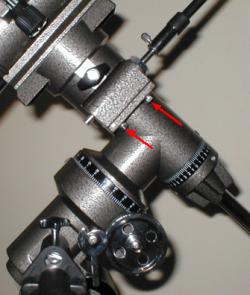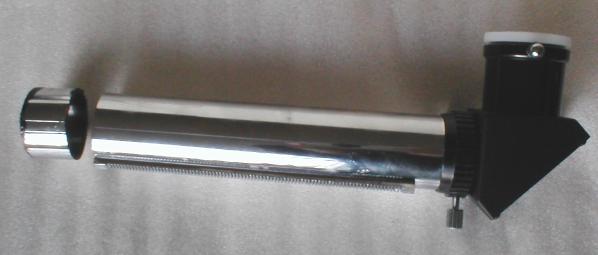LIDL, Tuning the SkyLux
Background Story
The German discounter market offers regularly bugdet
gadgets, such as telescopes and microscopes. In December 2004 we
customers were blessed with one microscope and two telescopes within
just two weeks. Lets forget about the microscope for the moment (nice
pice though, guess what, I bought one).
Two telescopes? Yes, two different ones. First the (for
LIDL legendary) 70mm f/10 Fraunhofer refractor on an equatorial mount
made it's way to the supermarkets. Later, maybe even better, the
MEADE ETX-70 was provided in a very nice bundle for a more than
competitive price...
This blabla though shall be about the first of the two
mentioned; infos about the ETX-70 are to be found on other places on
this webpage.
De-/ Greasing the Mount
The mount appears to be similar to the Chinese
„Astro3“-mount sold in various places. A motor is
available for this mount, thus, a motor is available for the
LIDL-mount too. Two different versions even, I went for the more
expensive „hand-box“ controlled one for about €100.-
at my favorite telescope shop.
Having a motor driving your right
ascension axis you certainly would prefer that the mount moves
smoothly by a thumbs twist, preferably w/o any major forces when the
telescope is nicely balanced.
 When the mount came out of the
box, it did not really want move at all. Sticky grease was literally gluing the
axis to the bearings. Taking everything apart is not a big deal. Thus removing
the grease and replacing it with precision mechanics oil is not very difficult
either. In fact I more or less soaked all gears and bearings in oil,
resulting in a very well lubricated and nicely moving equatorial mount. Actually I even cared
about the declination axis, even though this appears not be very
important, it still is nice to have a smooth DEC-handling too. So,
taking apart the RA-axis requires just to loosen the hex-nut
in the mount's base (see image). Be careful, all sorts of washers are involved,
e.g. a spring-washer is waiting just behind the bolt, waiting
to fall off and get lost.... Anyway, if all important parts
are lost, you can easily pull out the axis, having a good chance to
even loose more parts such as washers ;-) Cleaning all
the re-found parts from itchy grease shall not be a problem, applying
the appropriate oil neither... you should watch out to use lube
which is suitable for the materials used in the mount.
When the mount came out of the
box, it did not really want move at all. Sticky grease was literally gluing the
axis to the bearings. Taking everything apart is not a big deal. Thus removing
the grease and replacing it with precision mechanics oil is not very difficult
either. In fact I more or less soaked all gears and bearings in oil,
resulting in a very well lubricated and nicely moving equatorial mount. Actually I even cared
about the declination axis, even though this appears not be very
important, it still is nice to have a smooth DEC-handling too. So,
taking apart the RA-axis requires just to loosen the hex-nut
in the mount's base (see image). Be careful, all sorts of washers are involved,
e.g. a spring-washer is waiting just behind the bolt, waiting
to fall off and get lost.... Anyway, if all important parts
are lost, you can easily pull out the axis, having a good chance to
even loose more parts such as washers ;-) Cleaning all
the re-found parts from itchy grease shall not be a problem, applying
the appropriate oil neither... you should watch out to use lube
which is suitable for the materials used in the mount.
RA-Handle mod
Lets talk about the
declination axis. Sure, the lube is applied by now, but what
is about the DEC-handle? Terrible, isn't it? Yes, terrible! Tracking
in RA causes interaction between the DEC-handle and the rest of the
mount, i.e. bocking all tracking. What can we do to solve that sort
of problem? Lets dismantle the worm-gear of the DEC-drive. Two
hexagonal bolts are to be removed (left photo), you will have the
worm and it's bearings removed from the mount. Next step: loosen the
hexagonal bolt of the bearing (right photo). Everything taken apart,
it is no problem to assemble everything with the worm in a reversed
orientation (after cleaning off all sticky grease and applying
appropriate oil).
Please note that the
photographs below show the already modified mount.
|

|

|
|
The two hex-bolts to be loosened.
|
The bearing-hex to be removed.
|
Optics
Mechanics are one part, but also the optics design is
not yet ideal for astronomical purposes. Why? The LIDL scope,
according to many publications on the Internet (especially in German
language), the optics are designed to also serve the purpose of
terrestrial observations w/o the use of the diagonal which is
somewhat standard to astronomical observations. In astro-obs, using a
diagonal, the focuser is retracted almost completely into the
telescope tube. The design of the scope actually prefers terrestrial
observations; an aperture stop is inserted in the focuser, even the
focuser tube cuts a portion of light out itself, when retracted into
the scope whilst the use of the diagonal.
First one would
like to remove the focuser by removing the two Phillips-screws, trying to find
back the spring which certainly dropped to the ground somewhere... With
having removed the handle, so that the sprocket does not
engage with the cograil anymore, the focuser-tube can now be pulled out easily. BTW,
the
sticky grease is also present in the focuser, here it is welcome, so,
do not remove it... otherwhise the focuser will defocus by the
weight of the eyepiece when moving to easily.
|

|

|
|
Remove the two screw to dismount the focuser.
|
This spring waits below...
|
|
The aperture stop can
be removed by pushing it out towards the objective direction of the
focuser tube, this will not affect the optics for astronomical observations i.e.
using the diagonal mirror.
|

|
The surplus part of the focuser tube beyond the
cograil of the focuser is arbitrary per se and
can thus be removed, e.g. sawed off.
Painting the inside of the focuser tube
with non-reflective black paint could possibly improve the contrast of the
scope. This, however, I have not done yet.
|

|
|
Focuser and the part that has been removed.
|
Last modified Jan. 9th 2005
 When the mount came out of the
box, it did not really want move at all. Sticky grease was literally gluing the
axis to the bearings. Taking everything apart is not a big deal. Thus removing
the grease and replacing it with precision mechanics oil is not very difficult
either. In fact I more or less soaked all gears and bearings in oil,
resulting in a very well lubricated and nicely moving equatorial mount. Actually I even cared
about the declination axis, even though this appears not be very
important, it still is nice to have a smooth DEC-handling too. So,
taking apart the RA-axis requires just to loosen the hex-nut
in the mount's base (see image). Be careful, all sorts of washers are involved,
e.g. a spring-washer is waiting just behind the bolt, waiting
to fall off and get lost.... Anyway, if all important parts
are lost, you can easily pull out the axis, having a good chance to
even loose more parts such as washers ;-) Cleaning all
the re-found parts from itchy grease shall not be a problem, applying
the appropriate oil neither... you should watch out to use lube
which is suitable for the materials used in the mount.
When the mount came out of the
box, it did not really want move at all. Sticky grease was literally gluing the
axis to the bearings. Taking everything apart is not a big deal. Thus removing
the grease and replacing it with precision mechanics oil is not very difficult
either. In fact I more or less soaked all gears and bearings in oil,
resulting in a very well lubricated and nicely moving equatorial mount. Actually I even cared
about the declination axis, even though this appears not be very
important, it still is nice to have a smooth DEC-handling too. So,
taking apart the RA-axis requires just to loosen the hex-nut
in the mount's base (see image). Be careful, all sorts of washers are involved,
e.g. a spring-washer is waiting just behind the bolt, waiting
to fall off and get lost.... Anyway, if all important parts
are lost, you can easily pull out the axis, having a good chance to
even loose more parts such as washers ;-) Cleaning all
the re-found parts from itchy grease shall not be a problem, applying
the appropriate oil neither... you should watch out to use lube
which is suitable for the materials used in the mount.





